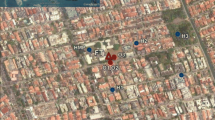Abstract
A new parametrization for the surface energy balance of urban areas is presented. It is shown that this new method can represent some of the important urban phenomena, such as an urban heat island and the occurrence of a near-neutral nocturnal boundary layer with associated positive turbulent heat fluxes, unlike the traditional method for representing urban areas within operational numerical weather prediction (NWP) models. The basis of the new parametrization is simple and can be applied easily within an operational NWP model. Also, it has no additional computational expense compared to the traditional scheme and is hence applicable for operational forecasting requirements. The results show that the errors for London within the Met Office operational mesoscale model have been significantly reduced since the new scheme was introduced. The bias and root-mean-square (rms) errors have been approximately halved, with the rms error now similar to the model as a whole. The results also show that a seasonal cycle still exists in the model errors, but it is suggested that this may be caused by anthropogenic heat sources that are neglected in the urban scheme.
Similar content being viewed by others
References
A. C. M. Beljaars A. A. M. Holtslag (1991) ArticleTitle‘Flux Parametrisation over Land Surfaces for Atmospheric Models’ J. Appl. Meteorol 30 327–341
M. J. Best (1998) ArticleTitle‘A Model to Predict Surface Temperatures’ Boundary-Layer Meteorol 88 279–306
M. J. Best W. P. Hopwood (2001) ArticleTitle‘Modelling the Local Surface Exchange over a Grass-Field Site under Stable Conditions’ Quart. J. Roy. Meteorol. Soc 127 2033–2052
Black, P. B. and Tice, R. A.: 1988, Comparison of Soil Freezing Curve and Soil Water Curve Data for Windsor Sandy Loam, US Army Cold Regions Research and Engineering Laboratory Report, 88:16, 37 pp.
R. Bornstein Q. Lin (2000) ArticleTitle‘Urban Heat Islands and Summertime Convective Thunderstorms in Atlanta: Three Case Studies’ Atmos. Environ 34 507–516
A. T. Chan E. S. P. So S. C. Samad (2001) ArticleTitle‘Strategic Guidelines for Street Canyon Geometry to Achieve Sustainable Street Air Quality’ Atmos. Environ 35 4089–4098
G. J. Collatz J. T. Ball C. Grivet J. A. Berry (1991) ArticleTitle‘Physiological and Environmental Regulation of Stomatal Conductance, Photosynthesis and Transpiration: A model that Includes a Laminar Boundary Layer’ Agric. For. Meteorol 54 107–136
G. J. Collatz M. Ribas-Carbo J. A. Berry (1992) ArticleTitle‘A Coupled Photosynthesis-Stomatal Conductance Model for Leaves of C4 Plants’ Aust. J. Plant Physiol 19 519–538
B. J. Cosby G. M. Hornberger R. B. Clapp T. R. Ginn (1984) ArticleTitle‘A Statistical Exploration of the Relationships of Soil Moisture Characteristics to the Physical Properties of Soils’ Water Resour. Res 20 682–690
P. M. Cox R. A. Betts C. B. Bunton R. L. H. Essery P. R. Rowntree J. Smith (1999) ArticleTitle‘The Impact of New Land Surface Physics on the GCM Simulation of Climate and Climate Sensitivity’ Clim. Dyn 15 183–203
P. M. Cox C. Huntingford R. J. Harding (1998) ArticleTitle‘A Canopy Conductance and Photosynthesis Model for Use in a GCM Land Surface Scheme’ J. Hydrol 212–213 79–94
M. J. P. Cullen (1993) ArticleTitle‘The Unified Forecast/Climate Model’ Meteorol. Mag 122 81–94
A. J. Dyer (1974) ArticleTitle‘A Review of Flux-Profile Relationships’ Boundary-Layer Meteorol 7 363–372
R. L. H. Essery M. J. Best R. A. Betts P. M. Cox C. M. Taylor (2003) ArticleTitle‘Explicit Representation of Subgrid Heterogeneity in a GCM Land Surface Scheme’ J. Hydrometeorol 4 530–543
J. R. Garratt (1992) The Atmospheric Boundary Layer Cambridge University Press Cambridge 316
C. S. B. Grimmond T. R. Oke (1995) ArticleTitle‘Comparison of Heat Fluxes from Summertime Observations in the Suburbs of Four North American Cities’ J. Appl. Meteorol 34 873–889
C. S. B. Grimmond H. A. Cleugh T. R. Oke (1991) ArticleTitle‘An Objective Urban Heat Storage Model and its Comparison with Other Schemes’ Atmos. Environ 25 311–326
H. Huang A. Yoshiaki A. Mitsuru T. Masamitsu (2000) ArticleTitle‘A Two-Dimensional Air Quality Model in an Urban Street Canyon: Evaluation and Sensitivity Analysis’ Atmos. Environ 5 689–698
J.-J. Kim J.-J. Baik (2001) ArticleTitle‘Urban Street-Canyon Flows with Bottom Heating’ Atmos. Environ 35 3395–3404
A. Martilli A. Clappier M. W. Rotach (2002) ArticleTitle‘An Urban Surface Exchange Parameterisation for Mesoscale Models’ Boundary-Layer Meteorol 104 261–304
V. Masson (2000) ArticleTitle‘A Physically-Based Scheme For The Urban Energy Budget in Atmospheric Models’ Boundary-Layer Meteorol 94 357–397
J. L. Monteith (1965) ArticleTitle‘Evaporation and the Environment’ Symp. Soc. Expl. Biol 19 205–234
J. L. Morison R. M. Gifford (1983) ArticleTitle‘Stomatal Sensitivity to Carbon Dioxide and Humidity’ Plant Physiol 71 789–796
S. Murakami R. Ooka A. Mochida S. Yoshida S. Kim (1999) ArticleTitle‘CFD Analysis of Wind Climate From Human to Urban Scale’ J. Wind Engin. Ind. Aerodyn 81 57–81
Y. Ohashi H. Kida (2002) ArticleTitle‘Local Circulations Developed in the Vicinity of Both Coastal an Inland Urban Areas: A Numerical Study with a Mesoscale Atmospheric Model’ J. Appl. Meteorol 41 30–45
T. R. Oke (1987) Boundary Layer Climates EditionNumber2 Cambridge University Press Cambridge 435
Y. Tominaga A. Mochida (1999) ArticleTitle‘CFD Prediction of Flowfield and Snowdrift around a Building Complex in a Snowy Region’ J. Wind Engin. Ind. Aerodyn 81 273–282
van den Hurk, B. J. J. M., Viterbo, P., Beljaars, A. C. M. and Betts, A. K.: 2000, Offline Validation of the ERA40 Surface Scheme, ECMWF Technical Memoranda 295, 42 pp.
P. J. Williams M. W. Smith (1989) The Frozen Earth: Fundamentals of Geocryology Cambridge University Press Cambridge 306
Author information
Authors and Affiliations
Additional information
The British Crown’s right to retain a non-exclusive royalty-free license in and to any copyright is acknowledged.
Rights and permissions
About this article
Cite this article
Best, M.J. Representing urban areas within operational numerical weather prediction models. Boundary-Layer Meteorol 114, 91–109 (2005). https://doi.org/10.1007/s10546-004-4834-5
Received:
Issue Date:
DOI: https://doi.org/10.1007/s10546-004-4834-5




